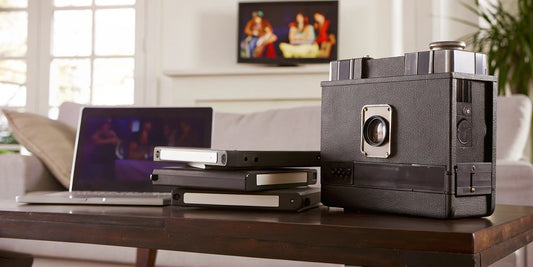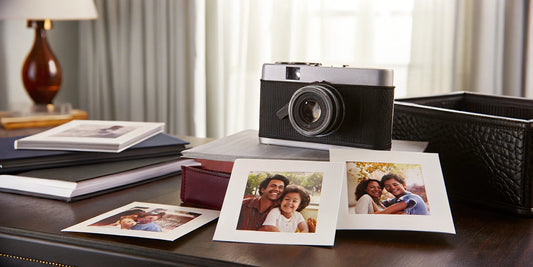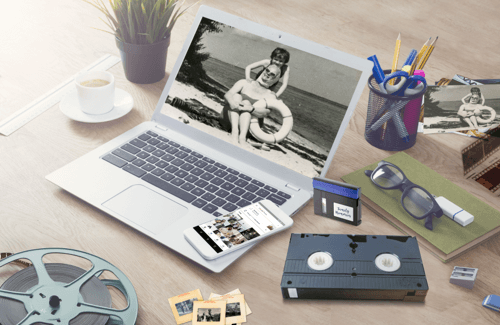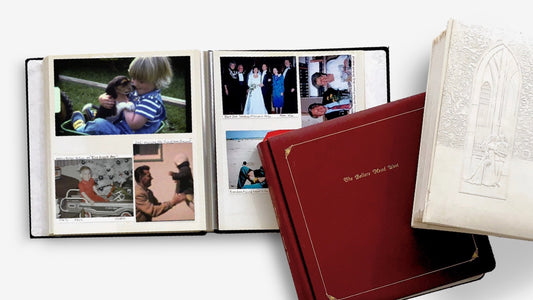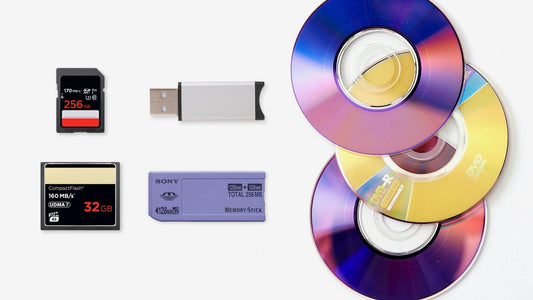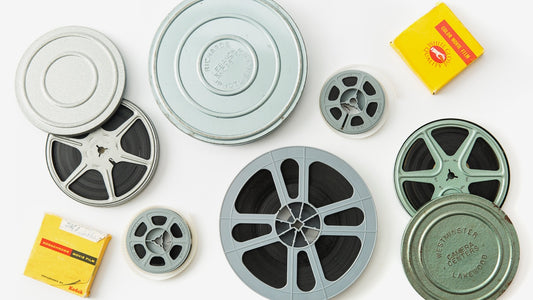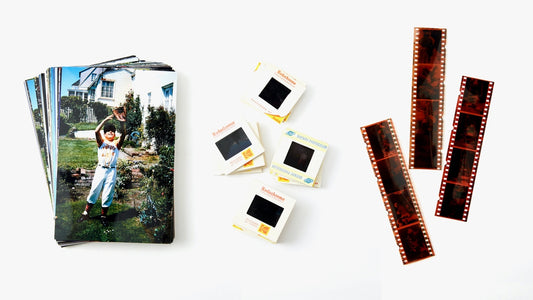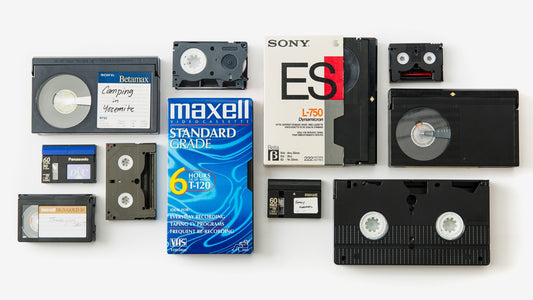That stack of Polaroids sitting in your closet holds some of your most candid and cherished memories. But how do you bring them into your modern digital life? You want to share them, back them up, and ensure they last forever. When you decide to scan Polaroids, you have a few different paths you can take. You can go the DIY route with a scanner or even your smartphone, giving you full control over the project. Or, you can hand them over to professionals who have the equipment and expertise to create flawless digital copies. This article will explore all the options, helping you choose the best method for your collection, budget, and technical comfort level.
Key Takeaways
- Digitizing is the best way to protect your Polaroids: Scanning creates a permanent copy of your one-of-a-kind photos, protecting them from fading, damage, and loss. You can get great results at home with a flatbed scanner or use a smartphone app for a quick and convenient solution.
- A few simple techniques make a huge difference: For a clean, glare-free scan, place your photo on a dark background and gently wipe it with a microfiber cloth. Setting your scanner to at least 600 DPI ensures you capture enough detail for future printing and sharing.
- Organize and back up your digital photos immediately: Once scanned, create a simple folder system by year and event. To keep your memories safe for the long term, save your files in at least two places, like an external hard drive and a cloud storage service.
Why Scan Your Polaroid Collection?
There’s something magical about holding a Polaroid. It’s a tangible piece of a moment, a one-of-a-kind snapshot you can pin to a board or tuck into a book. But as special as they are, physical photos are also fragile. Scanning your Polaroids doesn’t take away from the charm of the original; it protects the memory itself. By creating a digital copy, you give your favorite moments a permanent, safe home where they can be enjoyed for years to come, without the risk of damage or loss. It’s the best way to get the classic feel of instant film with the security and flexibility of a modern digital photo.
Save Your Memories for the Next Generation
Polaroids, like all physical photos, are vulnerable to the effects of time. Over the years, their vibrant colors can fade, and the images can suffer from scratches, spills, or accidental damage. By scanning your collection, you create a high-quality digital archive that won't degrade. This process ensures that the candid smiles, family vacations, and milestone celebrations captured in your Polaroids are preserved forever. Think of it as creating a digital family heirloom, a collection of memories that you can easily pass down to your children and grandchildren. A professional photo transfer service can help you create pristine digital copies that will stand the test of time.
Share and Back Up Your Photos with Ease
Once your Polaroids are digitized, sharing them becomes incredibly simple. Instead of worrying about the single original print getting lost in the mail, you can send copies to friends and family with a single click. You can post them on social media, use them in a digital slideshow for an anniversary, or print new copies for a photo album. Just as importantly, scanning creates a vital backup. If the original photo is ever lost or damaged, you’ll still have the digital version safe and sound. This gives you the peace of mind that your most cherished memories are protected, no matter what happens to the physical prints.
What You'll Need to Scan Your Polaroids
Before you start scanning, it’s a good idea to gather your tools. The great news is that you probably have everything you need right at home. Whether you prefer using a dedicated scanner for the highest quality or just the smartphone in your pocket for a quick and easy solution, there’s a method that will work for you. Let's walk through the different options and what you'll need for each one.
Choosing a Flatbed Scanner
If you’re aiming for top-notch quality, a flatbed scanner is your best bet. These devices are designed specifically for digitizing photos and documents, giving you crisp, high-resolution images. Models like the Epson Perfection V600 are popular for a reason—they handle photos beautifully. For Polaroids, a neat trick is to use a special holder that lifts the photo slightly off the glass. This prevents those distracting rainbow-colored rings (called Newton's rings) from appearing on your scan, ensuring your digital copy looks clean and professional.
Using Your Smartphone: Apps and Gear
Your smartphone is a powerful scanning tool you can carry anywhere. It’s perfect for digitizing photos quickly without any extra equipment. Several apps can help you get a great scan with just a few taps. The Notes app on an iPhone has a built-in document scanner that works in a pinch. For something more specialized, apps like Google PhotoScan guide you through the process to create a glare-free image. The official Polaroid app even has its own scanner feature. Just place your photo on a flat, dark surface, hold your phone steady, and let the app work its magic.
The Digital Camera Method
If you’re comfortable with a digital camera, you can easily set up your own scanning station. This method gives you a lot of control over the final image. A simple trick is to take a piece of black cardboard, cut a hole for your camera lens, and attach it. This helps block out any stray reflections. Place your Polaroid on a flat surface and position your camera directly above it, getting close enough to fill the frame. This DIY approach is fantastic for capturing the unique texture and character of your instant photos.
Proper Lighting and Backgrounds
No matter which method you choose, good lighting and the right background are essential. Always place your Polaroid on a dark, non-reflective surface, like a piece of black poster board. This helps minimize glare and makes the colors in your photo appear more vibrant. Natural light is your best friend here—try setting up near a window on an overcast day for soft, even lighting. Just be careful to avoid direct sunlight, as it can create harsh shadows and reflections on the glossy surface of the Polaroid.
Four Ways to Scan Your Polaroids
Ready to turn those stacks of Polaroids into digital files? Great! You have a few different options, each with its own pros and cons. Whether you’re looking for a quick solution using your phone or want the highest quality possible with a dedicated scanner, there’s a method that will work for you. Let’s walk through the four main ways to scan your instant photos.
Scan with a Flatbed Scanner
Using a flatbed scanner is a fantastic way to get high-quality, detailed digital copies of your Polaroids. If you already have one at home, you’re halfway there. The key is to handle your photos carefully to get the best results. One pro tip: avoid placing the Polaroid directly on the scanner's glass surface. The pressure can sometimes create strange marks or oily-looking rainbow patterns on your scan. To prevent this, you can use a special photo holder or even a simple spacer to create a tiny gap between the photo and the glass. This little trick ensures your scan is clean and artifact-free.
Scan with Your Smartphone
For a fast and surprisingly effective option, look no further than the phone in your pocket. Several apps are designed specifically for scanning old photos, and they do a great job of cropping the image and correcting for glare. Apps like Google’s PhotoScan guide you through taking multiple shots to create a single, glare-free image. Others, like Photomyne, make it easy to scan multiple photos at once. While it might not match the quality of a flatbed scanner, using your phone is perfect for quickly digitizing photos to share on social media or with family.
Scan with a Digital Camera
If you have a DSLR or mirrorless camera, you can set up your own scanning station. This method gives you a lot of control over the final image, especially if you’re comfortable with your camera’s manual settings. The simplest way to do this is to place your Polaroid on a flat, neutral-colored surface in a well-lit area, avoiding direct overhead lights that cause glare. Position your camera directly above the photo—using a tripod will help keep it steady and perfectly parallel. You can even create a simple tool by cutting a lens-sized hole in a piece of black cardboard to block reflections. This DIY approach takes a bit more setup but can produce excellent, high-resolution results.
Let the Pros Handle It: Professional Scanning
If you have a large collection of Polaroids or want to ensure they get the best possible treatment, consider a professional service. While DIY methods are great, nothing beats the quality and consistency of commercial-grade equipment operated by trained technicians. This is the most hands-off and reliable way to get crisp, color-accurate digital files from your precious memories. A professional photo transfer service is especially helpful for older, more fragile photos that require a delicate touch. You can send in your collection and get back perfectly scanned digital images, saving you time and the stress of troubleshooting any technical issues. It’s the ideal choice for preserving your most cherished moments.
Your Step-by-Step Guide to Scanning
Ready to turn that shoebox of Polaroids into a digital collection? It’s easier than you think. Following a few simple steps will help you get clear, vibrant scans that do your original photos justice. Let’s walk through the process together, from prepping your pictures to choosing the right settings.
Prepare Your Photos
Before you even think about scanning, take a moment to gently clean your Polaroids. Over the years, they’ve likely collected a bit of dust or a few fingerprints. Use a soft, microfiber cloth to carefully wipe the surface of each photo. This simple step makes a huge difference, preventing tiny specks from showing up in your final digital image. It also ensures you’re handling your precious memories with care. Taking the time to prep your photos now means you’ll have a beautiful, clean collection ready to be preserved and shared. If you're worried about handling fragile photos, our photo transfer service handles every image by hand.
Set Up Your Equipment
Now, let’s get your scanning station ready. If you’re using a flatbed scanner, give the glass a quick wipe with a clean cloth to remove any smudges or dust. For those using a smartphone or digital camera, your setup is just as important. Find a flat, stable surface next to a window with plenty of indirect natural light. Avoid direct sunlight, as it can cause harsh glare. You want soft, even lighting across the entire photo. A steady hand or a small tripod will also help you avoid blurry shots. Creating a consistent setup ensures all your scans will have a similar look and quality.
Position and Frame Your Polaroids
How you place your Polaroid for scanning can make or break the final image. Lay each photo completely flat on your scanner bed or surface. To make the iconic white border pop, try placing it on a dark, non-reflective background like a piece of black construction paper. This creates contrast and makes it much easier to crop the image later. Make sure your camera or phone is positioned directly above the Polaroid, perfectly parallel to it. Scanning at an angle can distort the photo’s shape, so take a moment to line everything up properly for a crisp, true-to-life result.
Choose the Best Scanner Settings
The right settings are key to capturing a high-quality digital copy. If your scanner software asks for a resolution, aim for at least 600 DPI (dots per inch). This gives you a detailed image that’s great for printing or zooming in on. For the file type, choose TIFF if you want an uncompressed, archival-quality file, or JPEG for a smaller file that’s perfect for sharing online. Always scan in color, even for black-and-white Polaroids, to capture the full range of tones. Many scanning apps also have built-in tools to help reduce glare, so be sure to explore those features before you start your digital media transfer.
Tips for Perfect Polaroid Scans
Getting a great digital copy of your Polaroid isn't just about having the right scanner; it's about using the right techniques. Because of their glossy finish and unique chemical makeup, Polaroids present a few challenges that regular photo prints don't. But don't worry—a few simple adjustments can make a world of difference, turning a frustrating process into a successful one. From avoiding that pesky glare to capturing the iconic colors just right, these tips will help you create beautiful digital versions of your favorite instant photos. If you find the process too detailed, remember you can always rely on a professional photo transfer service to handle the technical details for you.
How to Avoid Glare and Reflections
The glossy surface that makes Polaroids look so great can also be your biggest enemy when scanning, causing distracting glare and reflections. Pressing the photo directly against a flatbed scanner's glass can also create strange patterns called Newton's rings. The best way to avoid this is to create a small gap between the photo and the glass. You can use a special photo holder or spacer designed for your scanner. If you don't have one, simply placing the Polaroid on a piece of black cardstock can also help. The dark background absorbs excess light, reducing glare and making your image appear clearer and more defined.
Handle Fragile Photos with Care
Polaroids are more than just paper; they're tiny chemical laboratories. It's important to handle them gently to avoid smudges, fingerprints, or damage. Always hold them by the thick white borders. If you're scanning newly developed photos, make sure they have had plenty of time to cure in a well-ventilated area. For the best results, new Polaroids should develop in temperatures between 55 and 82 degrees Fahrenheit to prevent color shifts or distortions. Treating your photos with care before you scan ensures you're starting with the best possible source material, which is the first step to a great digital image.
Capture True-to-Life Color
Polaroids have a distinct, often dreamy color palette that can be difficult to replicate digitally. Many scanners have an "auto-correct" feature that tries to "fix" these unique colors, which can strip the photo of its character. Before you scan, check your scanner's settings and turn off any automatic color or tone adjustments. This gives you a more neutral scan that you can edit later. If you're using your phone, an app like the Polaroid App is designed to recognize the unique chemistry of their film and can help you capture a more accurate digital version without fighting against your phone's camera software.
What Resolution Should You Use?
Resolution, measured in dots per inch (DPI), determines how much detail your scan will capture. For Polaroids, you don't need to go overboard. A resolution between 600 and 1200 DPI is usually perfect. Scanning at 600 DPI is great for sharing online or making small prints. If you plan on enlarging the image or cropping it significantly, 1200 DPI will give you more flexibility. Scanning at a much higher resolution won't necessarily make the image look better; it might just emphasize the texture of the Polaroid's surface and create a massive file that's difficult to manage.
Troubleshooting Common Scanning Problems
Even with the best setup, you might run into a few hiccups while scanning your Polaroids. It’s completely normal! Most issues are easy to fix with a few simple adjustments. Instead of getting frustrated, think of it as part of the process of bringing these memories back to life. If you find yourself spending more time troubleshooting than scanning, remember that professional photo transfer services are always an option to get the job done right without the headache. But for the DIY route, let’s walk through some of the most common problems and how to solve them.
Problem: Too Much Glare
That glossy finish on Polaroids is great for looking at, but it can cause a frustrating amount of glare under a scanner. When you place an instant photo directly on a flatbed scanner, the pressure against the glass can create strange marks or reflections. To fix this, try placing a dark piece of paper or cloth behind the photo. This helps absorb some of the scanner's light and reduces reflections. If you're using your phone, avoid shooting directly overhead where your light source can bounce back into the lens. Instead, try holding your phone at a slight angle to find a position that minimizes that bright, distracting glare.
Problem: Colors Look Off
Do the colors in your scan look a little funky? Maybe the vibrant reds from that 80s birthday party look faded, or everyone has a slight blue tint. This often happens because the unique dyes in Polaroids can shift over time, and scanners sometimes exaggerate these changes. Before you scan, check your scanner’s software for color correction settings you can adjust. For more stubborn color issues, photo editing apps can be a lifesaver. Some apps are even specifically designed to handle the unique color profiles of instant film, helping you restore the tones to their original warmth and vibrancy with just a few taps.
Problem: Dust and Scratches
Dust, fingerprints, and tiny scratches can become glaringly obvious once a photo is digitized. The best defense is a good offense. Before you begin, gently wipe the surface of your Polaroids with a clean, dry microfiber cloth. Do the same for your scanner bed or the surface you’re placing the photo on. Setting your scanner to a high resolution will also help. While it might seem counterintuitive, a higher resolution captures more detail, making it easier to spot and edit out tiny imperfections later using the clone or healing brush tool in your favorite photo editor.
Problem: The Final Image is Blurry
A blurry scan can be a real letdown, but it’s usually caused by one of two things: movement or focus. If you’re using your phone or a digital camera, the slightest shake of your hands can result in a soft or blurry image. Try using a small tripod or propping your phone up on a stack of books to keep it perfectly still. If you’re using a flatbed scanner, make sure the Polaroid is lying completely flat against the glass and that the scanner lid is closed securely to prevent any movement during the scan. A quick wipe of your camera lens or scanner glass can also make a world of difference.
How to Edit Your Scanned Polaroids
Once your Polaroids are scanned, a little bit of editing can make a world of difference. The goal isn't to make them look like they were taken yesterday with a smartphone, but to restore their original charm and clean up any issues that happened during the scanning process. You don’t need to be a graphic designer or have expensive software to do this. Many simple, free tools can help you polish your digital memories so they’re ready to be shared.
Think of it as dusting off an old photo album—you’re just gently cleaning up the images so the memories can shine through. Simple adjustments can correct colors that have faded over time, remove distracting dust spots, and make the photo feel as vibrant as the moment it captured. While professional services handle all this for you, here are a few easy edits you can make yourself to give your photos that final touch.
Simple Edits for a Big Impact
You can make your scanned Polaroids look much cleaner with just a couple of quick fixes. The first step is often cropping and straightening. Use the crop tool in any basic photo editor to trim away the background of the scanner bed, leaving just the Polaroid and its classic frame. If the photo was scanned at a slight angle, the straighten tool will level it out perfectly.
Many user-friendly photo editing apps like Canva or even the built-in editor on your phone or computer are perfect for these tasks. These simple adjustments create a clean, polished look and make your digital photo feel intentional and well-preserved. It’s a small step that has a huge effect on the final result.
Correcting Color and Brightness
Over the years, the colors in Polaroids can fade or shift, often taking on a yellowish or bluish tint. Luckily, you can easily bring back some of that original vibrancy. Start by looking for sliders labeled “Brightness,” “Contrast,” and “Saturation” in your editing app. A slight increase in brightness can lighten a photo that looks too dark, while adjusting the contrast can make the details pop.
If the colors look washed out, gently increase the saturation to make them richer. Many apps also have a “Warmth” or “Temperature” slider that can help you correct any color cast—move it toward blue to cool down a yellowish photo or toward yellow to warm up a bluish one. The key is to make small, subtle adjustments until the photo looks natural and true to life.
Cleaning Up Dust and Blemishes
No matter how carefully you clean your Polaroids and scanner, tiny specks of dust or small scratches can show up in the final scan. These little imperfections can be distracting, but they’re usually easy to remove. Look for a tool called a “spot heal,” “retouch,” or “clone” tool in your editing app.
This feature allows you to click on a speck of dust, and the app will intelligently replace it with pixels that match the surrounding area, making the blemish disappear. It’s a bit like digital magic. Taking a few minutes to clean up these spots will give your photos a beautifully restored look. For more significant damage, like large tears or stains, a professional photo transfer service can provide more advanced restoration.
Save and Export Your Final Images
After you’ve made your edits, it’s time to save your work. It’s always a good idea to save your edited photo as a new file, so you can keep the original, unedited scan as a backup. When you go to save, you’ll likely see options for file type and quality. For sharing online or via email, saving as a JPEG at a high-quality setting is your best bet.
Once your edited photos are saved, they’re ready to go! You can easily share them with family and friends on social media, add them to a digital photo frame, or use them to create new prints and photo books. You’ve successfully brought your precious memories into the digital age, ready to be enjoyed for years to come.
Organize and Store Your Digital Photos
You’ve successfully scanned your Polaroids—congratulations! That’s a huge step in preserving your family’s history. But the work isn’t quite done yet. Now that your precious memories are in digital format, the next step is to organize and protect them. Think of your computer like a digital photo album; without some organization, it can quickly become as cluttered as an old shoebox full of loose pictures. Taking a little time now to create a system for your digital photos will save you so much time later. It ensures you can find that one perfect photo of your grandma’s smile or your childhood dog whenever you want to.
Whether you scanned your photos yourself or used a professional photo transfer service, you now have digital files that need a safe and logical home. A good system includes a clear filing structure, a reliable backup plan, and the right storage solution for your needs. This is the single most important thing you can do to protect these irreplaceable memories from being lost to a hard drive crash or accidental deletion. Let’s walk through a simple, three-step process to get your newly digitized Polaroids organized, backed up, and ready to share for generations to come.
Create a Simple Filing System
A good filing system doesn't have to be complicated. The best approach is one you’ll actually stick with. I recommend creating a main "Photos" folder, and inside that, create folders for each year. Within each year, you can make subfolders for specific events or months. For example, a photo from a family vacation in July 1995 would go into a folder path like: Photos > 1995 > 1995-07_Beach_Vacation. This simple, chronological structure makes it incredibly easy to find what you're looking for. You can also create separate folders for different media types to keep your scanned Polaroids distinct from your phone pictures. The key is to find a consistent way to organize your digital files that makes sense to you.
Back Up Your Memories (So You Never Lose Them)
This step is non-negotiable. Technology can fail, and you don’t want your memories to disappear with it. The safest strategy is to have your photos in three places: on your computer, on an external hard drive, and in the cloud. This "3-2-1" rule is the gold standard for keeping data safe. Start by copying your entire photo library to an external hard drive. Then, choose a cloud service to upload them to. This combination of a physical, local backup and a remote, cloud-based backup ensures that even if something happens to your computer or your house, your photos are still safe. It's a great habit to back up digital photos regularly, especially every time you add new pictures to your collection.
Choose the Right Cloud Storage
Cloud storage is essentially an online home for your photos, and it’s perfect for that crucial off-site backup. When picking a service, think about a few things: how much storage you need, how easy it is to use, and how simple it makes sharing. Popular services like Google Photos, Dropbox, and iCloud all have their own strengths. Some are great for automatically organizing photos with facial recognition, while others excel at simple file storage. Most offer a free starting tier, so you can try them out. The best part is that once your photos are in the cloud, you can easily share a link to an album with family and friends, no matter where they are. This makes it simple to organize your digital photos and share them with the people who matter most.
Related Articles
- How to Digitize Photos: A Complete Guide – YesVideo
- Scan Old Printed Photos to Digital – YesVideo
- 5 Best Ways to Convert Negatives to Digital – YesVideo
- Photo Preservation Tips Guide – YesVideo
Frequently Asked Questions
What's the easiest way to scan my Polaroids if I'm not very tech-savvy? The simplest method by far is to use your smartphone. Apps like Google PhotoScan are designed to walk you through the process step-by-step, helping you avoid glare and automatically cropping the photo for you. While it may not produce the same archival quality as a flatbed scanner, it's a fantastic and fast way to digitize your photos for sharing with family and on social media.
Why do my scans have weird rainbow patterns on them? Those oily-looking rainbow rings are a common issue called Newton's rings. They happen when the glossy surface of the Polaroid presses directly against the glass of a flatbed scanner. The best way to prevent this is to create a tiny, almost invisible gap between the photo and the glass. You can do this with a special photo holder or by simply placing the Polaroid on a piece of black cardstock before scanning.
Is it possible to fix the color on my old, faded Polaroids after scanning? Yes, you can definitely improve the color with some basic photo editing. Most editing apps have simple sliders for brightness, contrast, and saturation that can help bring a faded photo back to life. If your photo has a strong yellow or blue tint, look for a "temperature" or "warmth" tool to balance it out. The goal isn't to make it look brand new, but to restore some of its original character.
What's the most important scanner setting I should pay attention to? If you're using a flatbed scanner, the most important setting to get right is the resolution, which is measured in DPI (dots per inch). For Polaroids, a setting of 600 DPI is the perfect sweet spot. This will give you a high-quality digital file that's detailed enough for making new prints or cropping in on a specific detail, without creating a massive file that's difficult to store and share.
When should I consider using a professional service instead of doing it myself? Doing it yourself is great if you have the time and a smaller collection. However, you should consider a professional service if your photos are particularly old, fragile, or damaged. It's also the best choice if you have a large number of photos and want to ensure you get consistent, high-quality results without spending hours scanning and editing each one yourself. It saves you time and gives you peace of mind that your memories are in expert hands.


